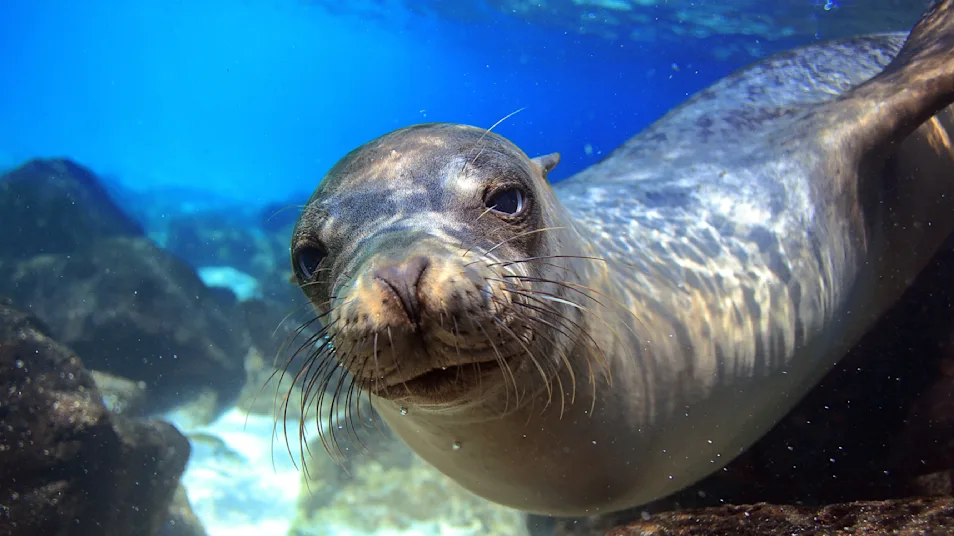
Know Before You Go


Giant Tortoise Facts | Galapagos Islands Wildlife Guide
The giant tortoise best symbolizes the Galapagos Islands. In fact, the word Galapagos is Spanish for “shape of a saddle,” which is what many tortoise shells actually resemble. Fourteen subspecies, each in some way distinctive to the island of its residence, comprise the sole giant tortoise species. Of these 14 varieties, three are extinct. One of the best ways to distinguish those still in existence, apart from geographic distribution, is by the differences in the shape of their shells. These differences, as described in The Voyage of the Beagle, contributed to the development of Darwin’s theory of evolution:
“I have not, as yet, noticed by far the most remarkable feature in the natural history of this archipelago; it is, that the different islands, to a considerable extent, are inhabited by a different set of beings. . . . I never dreamed that islands, about 50 or 60 miles apart, and most of them in sight of each other, formed of precisely the same rocks, placed under a quite similar climate, rising to a nearly equal height, would have been differently tenanted; but we shall soon see that this is the case. It is the fate of most voyagers, no sooner to discover what is most interesting in any locality, than they are hurried from it; but I ought, perhaps, to be thankful that I obtained sufficient materials to establish this most remarkable fact in the distribution of organic beings.”—Charles Darwin
Physical Characteristics
There are two major shell designs of the giant tortoise. The upper half of the shell, called the carapace, is distinct from the plastron, or lower half.
The “dome-shaped” carapace is found on larger varieties of tortoise from Santa Cruz and the Alcedo Volcano on Isabela, where the large tortoises feed on the relatively lush vegetation.
The “saddleback” carapace, found on the Hood (Española) and Pinta varieties, allows for the tortoise’s long neck to emerge, permitting it to feed on the hard-to-reach vegetation of the drier islands.
Males can grow to be up to 4 feet long and can weigh up to 700 pounds
Females can weigh up to 400 pounds
Range and Habitat
Giant tortoises are found only in the Galapagos Islands and prefer to live in dry lowlands, although some are found in the misty highlands on Santa Cruz. They are also found on the islands of Pinzon, Española and Isabela. In general, saddleback tortoises live in arid zones and feed mostly on cactus. Domed-shell tortoises are bigger and feed primarily on grass, so they inhabit more vegetated islands.
Behavior and Communication
Scientists believe the tortoise’s lifespan is somewhere around 150 years. They lead a relatively peaceful life, napping almost 16 hours per day. The rest of the time is spent foraging on leaves and cactus and basking in the sun.
As for communication, males groan loudly when mating, but it is the only vocalization they make. Females make no sounds at all. Their main method of communication is behavioral. Competing males will stand tall, necks stretched and facing each other with mouths agape. The highest head usually always wins.
Feeding Habits
Tortoises are vegetarians, and their diet includes grasses, forbs and leaves from trees and bushes. They have also been known to eat some strange foods such as stinging nettles and the crabapple-like fruits of the manzanillo tree, which can burn the skin of humans. They have very slow digestive systems; it can take their bodies up to three weeks to fully process a meal.
Known for their ability to go without eating for extended amounts of time, the tortoises voyaged to the islands aboard rafts of vegetation. They have tremendous water storage capacities, which enable them to survive long, arid seasons. This special attribute became a curse when buccaneers and whalers, who were keenly aware that the animals could withstand long voyages of up to one year without food or water, harvested them by the thousands for their meat. They were stored upside down in the bilge, ready for slaughter when fresh meat was on the menu. As a result of their endemic capture, only 15,000 remain today.
The shape of the tortoise’s shells has often been attributed to their feeding habits. A flatter shell allows them to stretch their neck up and reach for food that is higher off the ground.
Breeding and Reproduction
The giant tortoise reaches sexual maturity at about 40 years of age. From January through August, toward the end of the rainy season, the male begins to sniff the air, searching for a female’s scent. He will posture and heave competitive males to demonstrate his dominance, and then he will commence the quest for a female mate. Once a female is found, he chases her down and begins a unique style of courtship that involves intimidation. He knocks against her with the front of his shell and bites at her feet until she draws her legs in, which immobilizes her. At that point he mates with her. Males unsuccessful in finding a female partner have been known to attempt to mate with other males, or even with appropriately shaped boulders!
Having mated, the female looks for a dry, sandy area in which to make a nest. Starting a process that takes up to several days, she uses her hind legs to dig a hole approximately 12 inches deep. Between 2 and 16 eggs are laid, which are then covered with a protective layer of mud made from a mixture of soil and urine. The eggs take about four to five months to develop, and hatchlings usually emerge between December and April. When the eggs hatch, the baby tortoises are forced to fend for themselves, most dying within the first 10 years of life.
Conservation
Tortoises, specifically giant tortoises, have been the most devastated of all species in the Galapagos Islands. They were first exploited as a meat source, which is a practice that continues today, though at a lower rate. They are currently considered endangered and are strictly protected by the Ecuadorian government.
There is an effort to eradicate introduced mammals, such as rats that eat tortoise eggs, as well as to research tortoise ecology and genetics. A tortoise-breeding project at the Charles Darwin Research Station (CDRS) has been successful in introducing these animals into the wild in order to increase the depleted population.
Although the tortoises are in enclosures at the research station, visitors are permitted to enter to get a closer look at these giants, some of which could quite easily carry a fully grown man on their backs. Adults weigh more than 1,000 times their newborn hatchlings, which weigh less than 8 ounces.Photo Credit: Jeff A. Goldberg
See Giant Tortoises on These Galapagos Adventures

Galapagos Discovery: The Nat Hab Experience
Small-group adventures aboard your choice of private yachts, led by our outstanding naturalist guides and photography pros. Snorkel and swim with sea lions, sea turtles and penguins on this incomparable nature odyssey.































